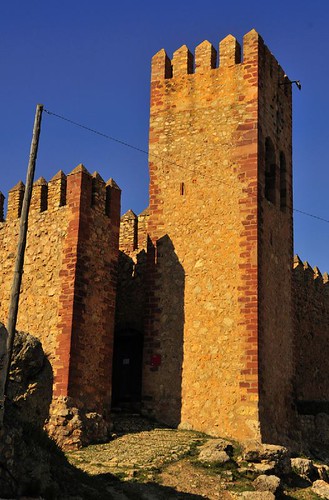
Molina de Aragon is located in the northeastern province of Guadalajara (Spain), has a population of approximately 4,000 inhabitants. Its climate is characterized by cold winters and harsh, and dry summers and warm, with large temperature fluctuations throughout the day, the rainfall is concentrated in the autumn and spring. Despite its foundation climatology medieval city is the center of a rich and diverse region, its strategic location and boundary of the estate outside the independent kingdoms of Aragon and Castile, their charter of reforestation and agricultural wealth, cattle and forest on the successful settlement of an urban character that has been kept alive over time.
The chronicles Roman Diodorus, Polybius and Strabo Celtiberians will be those that provide certain identity to the most populated city for several centuries. A period of desolation takes place throughout the area until the arrival of the Muslims and the creation of the Taifa kingdoms in s.Xl, that’s when the town of Molina appears under the mandate of the Moorish King Abengalbón, a tributary of Zaragoza and Valencia and good friend Cid as it appears in several verses of the Song.
This occupation ended the year 1129 when l Alfonso the Battler conquered the territory after months of siege. Don Manrique de Lara repopulated the land in 1139 and granted privileges that are recognized by the king in 1154, creating an independent dominion over several centuries. They will be the lords of Lara during the twelfth and thirteenth centuries which are to worry about enlarging the territory with many conquests and architectural works of great value, such as castles, walled enclosures, churches and convents, making a medieval village with Molina great privilege for people who come to settle these lands.
In 1369 Molina becomes part of the Kingdom of Aragon, Henry II is what gives the French Manor Duguesclin Molina as a reward for their help in the fratricide of Montiel, the molineses that do not support this agreement the city delivered to Peter IV King of Aragon, which rises to power for six years until 1375 is on this date when Molina Molina renamed by the Knights of Molina de Aragon, which is still preserved.
A century later, history repeats by the power of Lordship, when Henry IV decided to give Beltran de la Cueva, the molineses stand with their arms and get normalize the situation as so many times. Shortly after Isabella granted the privilege that always belong to Castilla Molina. It is early sixteenth century when Molina begins his time of splendor and development occurred by population growth and resource exploitation.
Another war episode takes place in 1810 with the War of Independence, the troops of General Roquet looted and burned the city to prevail desolation and destruction until molineses Determined to get help from troops to expel the lift area , the heroic courage shown by Fernando VII and the Cadiz Parliament in 1812 granted the title of city to our population.
The story is the legacy of the city and its inhabitants, who have been carving out the future of the times through effort and work their land. Molina now faces its future as a city renewed, modern, service center and a clear vocation for culture, heritage and tourism as engines of social and economic development.
How to visit? In Molina de Aragon there are many things to do, not to mention the walk through the old town and visit the Castle-Alcázar, walking through its streets you will find a wealth of churches and buildings that delight our vision and tell us about their history, such as : The Church of San Felipe, La Iglesia de San Francisco, La Iglesia de San Martín, El Palacio de los Molina, El Palacio del Marques de Villel, The Palace of the Garces de Marcilla, The Old Bridge and the Tower of Aragon.

We must also visit the Museo de Molina in the Cultural Center of San Francisco that it could call the museum of life, as it is intended through geology, paleontology, entomology and archeology, to understand how man comes to dominate their environment and create culture.
Gastronomy:
Molinesa traditional cuisine has some distinguishing features which by themselves justify a trip to this region. In many of its people still can taste the typical products of slaughter, the hams and exquisite morteruelo.
Other typical dishes are roast lamb roast, lamb trotters with tomato sauce, mushrooms and crumbs. The rainbow trout in its rivers are exquisite, are also famous quails and partridges to Bea. In point of sweets are famous legs of beef, fresh eggs and fried milk.
Holidays:
He started the year with the Feast of Butron, on May 1, molineses pilgrimage to the Ermita de la Virgen de la Hoz, which offers a great sardinada for all attendees.
On Pentecost Sunday is celebrated in the Barranco de la Hoz, The Loa to Our Lady, dance and praise to the Virgin. Coexistence Medieval Fair, the third weekend in June, which represents part of the Song of the Cid, in the old market and medieval dinner at the Plaza Mayor.
The Festival of Carmen, July 16, religious parades, escorting Lady of Mount Caramel through the streets of the city.
-Fairs and Festivals, from 31 August to 5 September in honor of the Blessed Christ of Victories.

«Finally to conclude the year takes place on 7 December, the feast of Our Lady of the Immaculate. Good Luck!
Leave a Reply
You must be logged in to post a comment.
Recent Comments